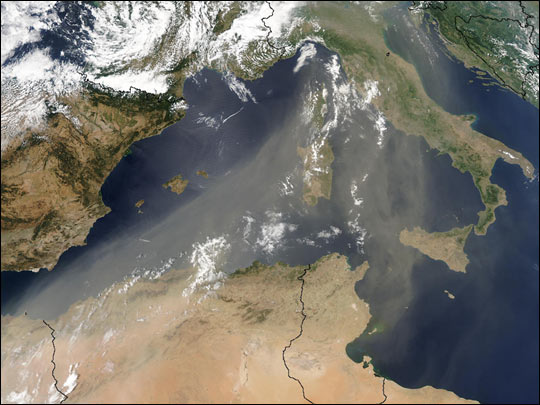
As climate warms, stronger Saharan dust storms will increase glacier melt, worsen air quality
A groundbreaking study shows that a warming planet will make dust storms more intense in the Mediterranean.
Using the highest-resolution continuous climate record ever published, the study explains the connections between dust storms, extended periods of drought, volcanoes and warming in the Mediterranean, Europe and Asia.
These ultrahigh-resolution records revealed stronger Saharan dust storms during past warming periods, and provide a glimpse of what to expect in the future.
More intense storms will impact glaciers by making them darker so they absorb more heat. More dust in the air will worsen air quality and impact public health, while also affecting the frequency of North Atlantic hurricanes.
The study is another milestone in the collaboration between the Initiative for the Science of the Human Past at Harvard and the Climate Change Institute at the University of Maine.
This interdisciplinary team of climate scientists, historians and archaeologists combined data from an ice core retrieved from the European Alps with highly detailed historical records.
Heather Clifford, a doctoral student at the Climate Change Institute, is first author.
“Understanding Saharan dust transport through time has countless applications — especially with high enough time-resolution to capture individual storm events,” says Clifford.
“We hope this record will unlock new opportunities to learn about the long-term effects of Saharan dust storms on ecology, human health and climate change.”

In the past, dust storms occurring at the same time as rainstorms often were recorded as “blood rain” due to the reddish color of Saharan dust.
The melting of glaciers caused by human-made climate change will contribute to erasing a vital source of information to study climate change itself, since ice from these millennia-old natural archives routinely reveals how climate patterns have changed over time and how climate will change in the future.
To address the crisis, the Climate Change Institute’s W.M. Keck Laser Ice Facility created a nondestructive system that allows preservation of the ice indefinitely, while providing climate data of the unprecedented ultra-high resolution which alone is compatible with detailed historical data.
The new technology offers a truly transformative solution to both the study and the effects of climate change at the cutting edge of research.
“This outstanding new set of data highlights how climate change will affect people’s health, due to worsening air quality, and how dust will also threaten the survival of glaciers and the ecosystems that depend on them,” says Alex More, co-author and assistant research professor and research associate at the CCI and Harvard University.
“The combination of both natural and historical records once again reveal information that neither type of data alone could have.”
The article is published in JGR Atmospheres, a journal of the American Geophysical Union, the premier professional association dedicated to the study of climate and environmental change.
Additional co-authors from the Climate Change Institute include Nicole Spaulding, Andrei Kurbatov, Elena Korotkikh, Sharon Sneed, Mike Handley, Kirk Maasch and Paul Mayewski.
Co-author Michael McCormick is with the Initiative for the Science of the Human Past at Harvard and co-author Joyce Chaplin is with the History Department at Harvard. Co-author Christopher Loveluck is with the Department of Archaeology at the University of Nottingham.
“Our joint Harvard-UMaine project is very proud of the amazing contribution to climate science presented by Heather [Clifford] for her Master of Science,” says Mayewski. “She is now a Ph.D. student and continues to work with us on this and other projects.”
The research is supported by funding from Arcadia, a charitable fund of Lisbet Rausing and Peter Baldwin. All datasets on which the study is based are provided in open access to the public. In addition, support for method development and analysis was provided by the W.M. Keck Foundation and the National Science Foundation.
Contact: Alex More, afmore@fas.harvard.edu, 617.417.5608; Beth Staples, 207.581.3777, beth.staples@maine.edu
